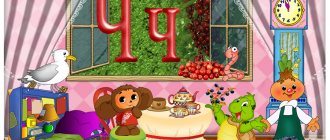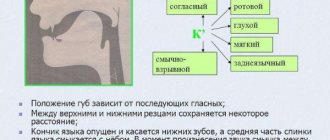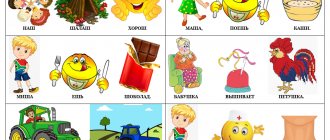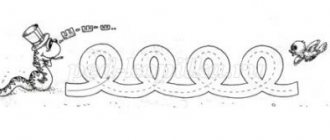Automation of the J sound in words:
For automation in words, you can use speech material that contains the sound Y, as well as those words that contain the letters Y-Y-Y-E, etc.
There are quite a lot of such words: [YA] - Pit, pit, sneak, java, turnout, berry, poison, tongue, core, yakut, yak, anchor, skiff, manger, testicle, egg, coachman, yacht, yacht, box, January , amber, fair, apple, apple tree, hawk, lamb, Yana, bright, clear, ash, Yasha, Jacob, Jadwiga, barley, jasper, lizards, tier, Paradise, Zoya, May, soybean, fairy, lighthouse, milkmaid, button accordion , mine, solder, belt, pendulum, piano, flock, thuja, yours, needles, Tatyana, Agafya, seamstress, muslin, idea, harness, trees, cameo, statue, magic, mania, comedy, station, November, neck, surname , brothers, new, bathroom, quiet, history, Ksenia, guest, jet, family, bench, pig, statue, feathers, spears, rods.
[YO] - Hedgehog, hedgehog, Christmas tree, Christmas tree, container, ruff, brush, fidget, shudder, mine, yours, his, drinks, sings, gives, chews, forges, takes out, sews, pours, pond, Mayovka, border, rising, drinking, flair, beast, gun, spear, blowing, washing, linen, whining, housing, living.
[YU] – south, skirt, cabin boy, youth, young man, youth, Juno, humor, yurt, Julia, Yura, spinning top, julit, loach, cabin, union, howl, give, chew, forge, dig, sow, sing, wash, drink, know how, know, bathe, lift, stand, read, comfort, lull, June, July, draw.
[YE] – Eva, food, riding, Egor, hedgehogs, Efim, ate, spruce, eat, blackberry, daily, raccoon, fidget, barely, unit, nonsense, if, echidna, go, more, Emelya, huntsman, howls, barks, washes, whines, digs, melts, walks, fighter, train, entrance, rider, movement, animal, insect, occupation, singing, boiling, diet, skill, weapon, roast, health, happiness, cookies, jam, two, three.
[Y] - iodine, yogurt, T-shirt, sink, barn, parrot, may, tea, teapot, bunny, snake, stand, jay, drink, neck, give, mine, fight, swarm, edge, yours, stream, nightingale, taiga, husky, cod, deuce, three, seagull, bike, massacre, buffalo, trickle, construction, loaf, bunk, bench, penny, housewife, glue, snake, harvest, pollock, China, surf, cowboy, peace, frost, sparrow, museum, hockey, Timofey, low, wild, quiet, tall, sonorous, dilapidated, new, smart, dark, edge, tram, ant, sweatshirt, nut, rack, gang.
Automation of the J sound in words with two sounds:
Eggs, bright, clear, Japan, radiance, charm, Maya, southern, young, nimble, Evsey, Eugene, caustic, hedgehog, foyer, hired, anniversary.
Automation of the J sound in phrases:
- drive geese;
- the bunny is jumping;
- run quickly;
- May day;
- green Garden;
- young fairy;
- hungry hyena;
- leather belt;
- wounded soldier;
- wallpaper glue;
- drives barely, etc.
Technique for setting vowel sounds
Among the most common methods for producing vowel sounds is the method of F.F. Rau, N.F. Slezina and the methodology of K.A. Volkova.
The first of them provides:
- Pronounce the vowel for a long time as part of syllables and in isolation.
- Practice the vowel in syllables and in isolation, abruptly, briefly.
- Change the volume of the sound when pronouncing it.
- Pronounce the vowel phoneme, placing stress on it, as well as unstressed syllables and words.
- Distinguishing vowels in syllables.
K.A. Volkova suggests performing the following types of exercises:
- Speak the sound in isolation.
- Pronounce a vowel with tension in the articulatory organs: positions under stress; and at the beginning of a word; at the beginning of a syllable.
- Practice under stress and in an unstressed position.
- Pronounce at the beginning of a word, syllable, at the end, between consonants, i.e. change the position of the sound.
- Distinguish vowels in syllables and words.
Individual lessons in difficult cases
It is more logical to give preference to individual lessons in difficult cases when the pronunciation of vowel sounds is impaired (for example, in hearing-impaired and deaf children or with rhinolalia, dysarthria). To do this, the teacher has various ways of posing problem sounds in his arsenal.
For example, to eliminate Y-shaped articulation, in addition to imitative exercises, a mechanical method, when the speech therapist presses the back of the tongue with a spatula, has a good effect. The same method is also suitable for narrowing the articulation of vowels O, U.
If a child has anterior articulation of sounds, this can be eliminated mechanically as follows: press the front part of the tongue with a spatula and push it back.
To close the passage into the nasal cavity and eliminate nasal tint, lightly press the root of the tongue with a spatula.
The sound A is usually placed by imitation, in the game. For example, a child is given a doll and asked to show how to rock it: ah-ah.
The sound O is well placed mechanically, starting from A. The speech therapist asks the child to pronounce the sound A, and in the meantime he brings the child’s lips together, giving them a rounded shape. You can also use various rings or bagels.
A speech therapist performs similar actions when setting the U. Only now here you need to build on the set O and bring the child’s lips even closer together.
The sound E. It is placed by imitation, starting from the vowel A in comparison.
When setting the Y, you can build on the articulation of the I. A spatula is used, because The oral gap is narrow when pronouncing the phoneme I. The speech therapist should press slightly with a spatula on the anterior lobe of the tongue and move it slightly deeper into the mouth. You need to invite the child to compare the sound of the sounds I-Y in syllables. For example, Pi - Py. It is also necessary to control the position of the lower jaw - it should not move forward.
Articulation gymnastics
The key to correct articulation of sounds, including vowels, is sufficiently developed mobility and switchability of the organs of the speech apparatus, as well as developed speech breathing. The functioning of the speech organs can be improved through articulatory gymnastics. There are various exercises for the lips, cheeks, lower jaw and tongue. It is good to give tasks in a playful way so that they arouse the child’s interest and desire to repeat them.
Exercise “Garazhik”. Let's imagine that the mouth is a garage into which cars drive. Once - open your mouth wide and hold it in this position for up to 5 seconds, until all the cars start moving. Two - close the garage. The tongue lies quietly at the bottom of the mouth. Repeat at least 3 times.
“Hamster.” The speech therapist shows a picture of a hamster, paying attention to how its cheeks are puffed up. Then he invites the child to puff out his cheeks too. When performing the task, the mouth must be closed. After 5 seconds, you need to release the air through your lips.
If the child does not succeed in this exercise, then you can simply invite him to blow, squeezing his lips with his fingers at this moment, as a result of which the air from inside will inflate his cheeks. Repeat 3 times.
"Puppy". The speech therapist shows a picture of a dog (she bares her teeth) and a boy (he smiles). The teacher draws the child’s attention to how the puppy and boy show their teeth and offers to show their teeth in the same way. The exercise is performed in front of a mirror 2-3 times. You can also read simple, funny poems on the theme of the picture.
Several articulatory gymnastics exercises can be united by a common theme. For example, invite your child to put animals from various exercises on a fun train. We’ll put a hamster in the first trailer (children puff out their cheeks), a puppy in the next one (smile), etc.
Also effective exercises include “Needle”, “Swing”, “Fence”, “Horse”.
Disadvantages of vowel pronunciation
Among the shortcomings in the pronunciation of vowel sounds, there are those that are characteristic of the entire vowel series or several sounds from it.
- Nasalization, when the nasal resonator does not participate correctly in articulation: the entrance to the nasal cavity remains open. Considered a gross defect.
- Expanded articulation. The mouth opens wider than required for correct pronunciation. Because of this, the rounding of the lips when pronouncing labialized sounds becomes less. The rise of the tongue with such a wide opening is reduced.
- Narrowed articulation. The mechanism of action is the opposite of that described above. Considered a gross defect.
- Front articulation. Characteristic of O, U. Occurs due to the fact that the tongue is retracted slightly back into the mouth. In this case, its tip is close to the lower incisors, the back stands in a lump.
- Raising your voice. Severe pronunciation defect U, I.
- Y-shaped pronunciation when the vowel sounds close to Y. Typical for A, O, E, I.
There are pronunciation errors that are specific to specific sounds.
- And it sounds similar to L. In speech it will look like this: instead of writing, weep; instead of throwing, we cry.
- When pronouncing the phoneme E, the tongue peeks out of the mouth and rests on the lower lip.
Most often this happens when the child is shown too much articulation.
- Y. More protrusion of the lower jaw than necessary. As a result, the position of the jaws becomes similar to a progenic bite.
As a rule, it appears when the teacher incorrectly shows the differences between Y and I.






